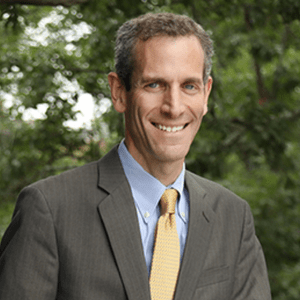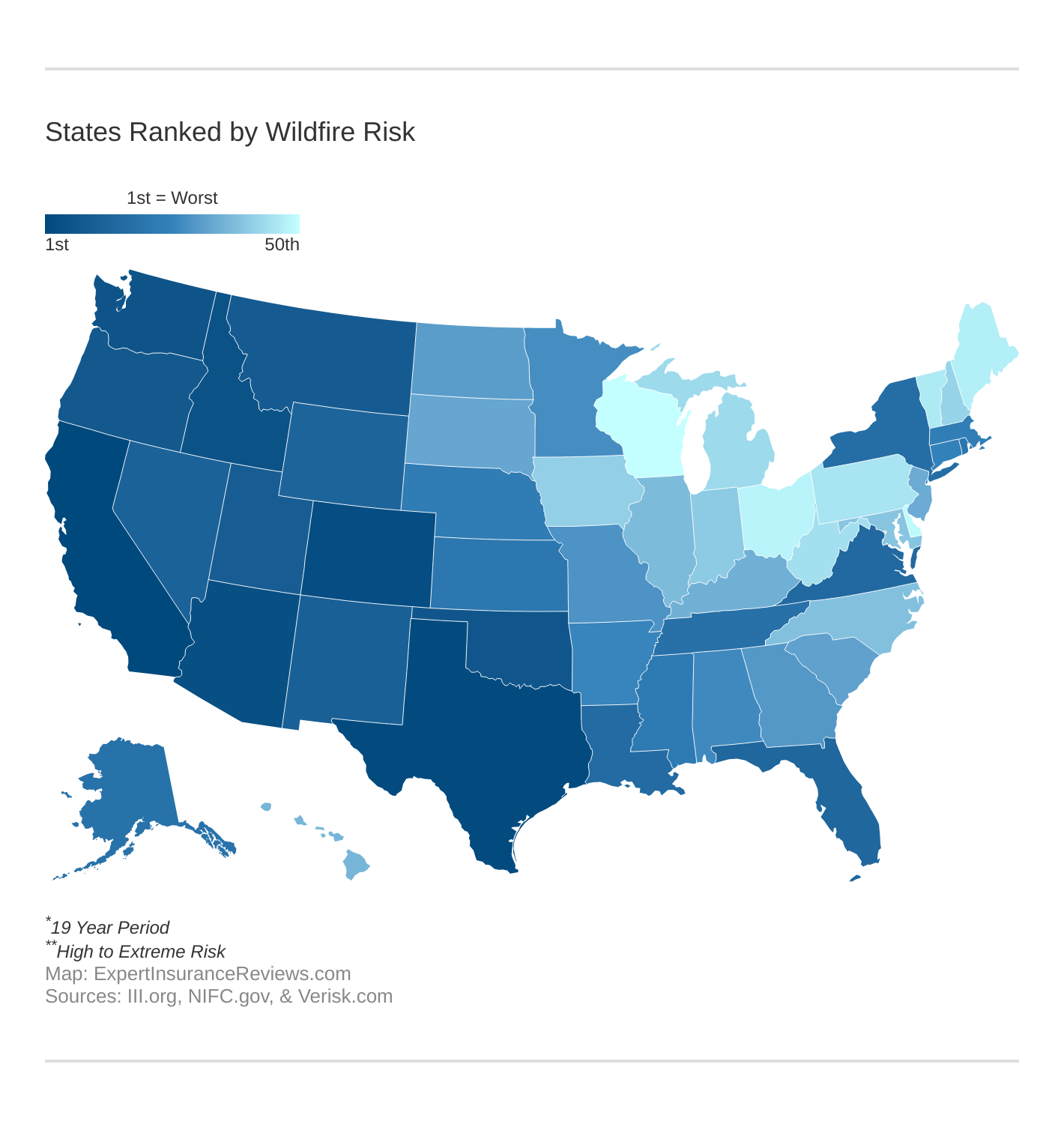10 States With the Highest Wildfire Risk (2025 Findings)
The 10 worst states for wildfires had a total of over 4 million properties and 144 cities put at risk from wildfires over a 19-year-period. In some states, high wildfire risk has led to home insurance companies dropping their customers. Practicing wildfire risk mitigation around your home, such as removing dead vegetation, can help reduce the risk of damages.
Read moreFree Home Insurance Comparison
Compare Quotes From Top Companies and Save
Secured with SHA-256 Encryption
Dani Best
Licensed Insurance Producer
Dani Best has been a licensed insurance producer for nearly 10 years. Dani began her insurance career in a sales role with State Farm in 2014. During her time in sales, she graduated with her Bachelors in Psychology from Capella University and is currently earning her Masters in Marriage and Family Therapy. Since 2014, Dani has held and maintains licenses in Life, Disability, Property, and Casualt...
UPDATED: Feb 6, 2024
It’s all about you. We want to help you make the right coverage choices.
Advertiser Disclosure: We strive to help you make confident insurance decisions. Comparison shopping should be easy. We are not affiliated with any one insurance provider and cannot guarantee quotes from any single provider.
Our insurance industry partnerships don’t influence our content. Our opinions are our own. To compare quotes from many different insurance companies please enter your ZIP code on this page to use the free quote tool. The more quotes you compare, the more chances to save.
Editorial Guidelines: We are a free online resource for anyone interested in learning more about insurance. Our goal is to be an objective, third-party resource for everything insurance related. We update our site regularly, and all content is reviewed by insurance experts.
UPDATED: Feb 6, 2024
It’s all about you. We want to help you make the right coverage choices.
Advertiser Disclosure: We strive to help you make confident insurance decisions. Comparison shopping should be easy. We are not affiliated with any one insurance provider and cannot guarantee quotes from any single provider.
Our insurance industry partnerships don’t influence our content. Our opinions are our own. To compare quotes from many different insurance companies please enter your ZIP code on this page to use the free quote tool. The more quotes you compare, the more chances to save.
On This Page
- There were a total of 684 threatening wildfire occurrences to cities in the 10 states with the highest wildfire risk
- In some states, insurers have dropped homeowners living in high-risk wildfire areas
- Wildfires are worse during times of drought and can spread easily with high winds
Every year, wildfires put over 4 million properties in the U.S. at risk and cause billions of dollars in damages. In states where wildfires are common, homeowners have been left in shock when their insurers suddenly dropped their homeowner insurance. If you live in an area with high wildfire risk, you might be concerned this could happen to you, even if you are paying an exorbitant amount for home insurance.
Be aware of the wildfire risk in your area and plan ahead to make sure you are covered by doing things such as checking mandatory coverage laws in your area. In addition to covering which states have the highest wildfire risk, we will cover the following:
- Top Wildfire States Compared to U.S. Wildfires
- Assessing Properties’ Wildfire Risk
- Tips for Wildfire Safety
- Frequently Asked Wildfire Questions
Are you adequately protected for wildfires by your homeowners insurance policy? You can use our free online quote comparison tool to find policies and rates to fit your needs. Enter your ZIP code to get started.
Read on to see which states are most likely to have wildfires that destroy homes so that you can begin to compare home insurance coverages and make sure you are protected.
10 Worst States for Wildfires
To find which states have the highest wildfire risk, and therefore the biggest chance of homeowners being dropped, our researchers analyzed wildfire data from the National Interagency Fire Center (NIFC). Using the NIFC data and data from Verisk on wildfire risk assessment, our researchers calculated the number of properties at risk, the number of cities at risk, and the number of total fire threats to each city.
The states were first ranked by the numbers of cities and properties at risk, calculated from the NIFC and Versisk, before being ranked by the average annual cost of homeowner’s insurance, collected from the Insurance Information Institute (III). Take a look at the complete rankings in our wildfire risk map for 2021 below.
Below is an in-depth look at the wildfire risk in the 10 worst states.
#10 – Utah
- Properties Put at Risk From Wildfires: 136,000
- Average Annual Cost of Home Insurance: $730
Utah is No. 10 on our list, with a total of 30 threatening wildfire occurrences over a 19-year period. Utah has had a number of devastating fires over the last decade, from the Pole Creek Fire to the Clay Springs Fire, both of which burned over 100,000 acres of land.
Some of the causes behind Utah’s biggest fires include lightning, human causes, and power lines. If you own a home in Utah that is considered to be in a high-risk area, make sure you have great Utah home insurance.
#9 – Montana
- Properties Put at Risk From Wildfires: 137,800
- Average Annual Cost of Home Insurance: $1,237
In ninth place on our list is Montana, which had a total of 137,800 properties at high risk of being damaged by wildfires. Montana has had a number of large wildfires that wreaked havoc, from the Snider/Rice and Bear Creek Fires in 2020 to the record-breaking Lodgepole Complex Fire of 2017.
Because wildfires are such a problem in Montana, you risk being rejected by even the best insurance companies, so make sure to have your home insurance in order before moving into Montana.
#8 – Oregon
- Properties Put at Risk From Wildfires: 151,400
- Average Annual Cost of Home Insurance: $706
Oregon had 151,400 properties and two cities put at risk from wildfires over a 19-year period, earning it the No. 8 spot on our list. Oregon has thousands of acres burned every year from wildfires, causing millions of dollars worth of damages.
Some of the worst fires in Oregon in the last decade include the Eagle Creek Fire and Long Draw Fire, each of which burned about half a million acres.
#7 – Oklahoma
- Properties Put at Risk From Wildfires: 153,400
- Average Annual Cost of Home Insurance: $1,944
No. 7 on our list is Oklahoma, with a total of 153,400 properties put at risk, even though zero cities were threatened by wildfires. Droughts and heavy winds have contributed to some of Oklahoma’s biggest wildfires, such as the Rhea Fire in 2018.
Because Oklahoma experiences frequent wildfires, it is best to do your research before moving into the area and make sure you have good home insurance and comprehensive insurance on your car in case of fire damage.
#6 – Washington
- Properties Put at Risk From Wildfires: 160,500
- Average Annual Cost of Home Insurance: $881
The state of Washington comes in sixth place, with wildfires putting 160,500 properties at high to extreme risk over 19 years. Washington also had a total of 14 city-threatening wildfire occurrences over the years.
Like the other states on our list, drought and winds contribute to Washington’s wildfires, making them hard to contain.
#5 – Idaho
- Properties Put at Risk From Wildfires: 175,000
- Average Annual Cost of Home Insurance: $772
In Idaho, wildfires put 175,000 properties at risk, with a total of 38 wildfire occurrences threatening major cities over 19 years. Every year, thousands of acres of wildlands burn in Idaho.
While dry seasons lead to massive wildfires, Idaho still has small wildfires to combat every year.
#4 – Arizona
- Properties Put at Risk From Wildfires: 242,200
- Average Annual Cost of Home Insurance: $843
Arizona had a total of 242,200 properties put at high to extreme risk, along with 25 wildfire occurrences threatening cities. Since Arizona is a dry state with high temperatures, the number of wildfires shouldn’t come as a surprise.
Some of the worst wildfires, such as the Wallow Fire in 2011, burned over half a million acres and left lasting damages to woods across the state.
#3 – Colorado
- Properties Put at Risk From Wildfires: 373,900
- Average Annual Cost of Home Insurance: $1,616
A total of 373,900 properties have been put at risk from Colorado’s wildfires, earning Colorado the No. 3 spot on our list. Colorado’s dry climate makes it susceptible to wildfires.
A number of massive wildfires have burned in Colorado over the last few years, such as the Spring Creek Fire in 2018 that burned over 100,000 acres.
#2 – Texas
- Properties Put at Risk From Wildfires: 717,800
- Average Annual Cost of Home Insurance: $1,955
Second on our list is Texas, with 717,800 properties put at risk from wildfires and 26 wildfire threats to cities. With part of the state an arid desert and the other part humid and warm, Texas’ weather varies vastly across the state.
One commonality, however, is Texas’ wildfires. Texas’ forests are still recovering from wildfires over a decade ago, and firefighters work hard to battle new wildfires every year.
#1 – California
- Properties Put at Risk From Wildfires: 2,054,900
- Average Annual Cost of Home Insurance: $1,073
The number one state for wildfires is California. With 2,054,900 properties put at risk and 540 wildfire occurrences threatening cities, California has the highest wildfire risks out of any other state. One of the most recent and largest wildfires in California, the August Complex, burned over one million acres.
The dry seasons in California are when wildfires run rampant due to dry vegetation providing easy fuel for fire starters, such as lightning.
To check whether you live in one of the worst areas in California for wildfires, you can check wildfire risk maps through resources like Wildfirerisk.org.
Are you looking for free insurance quotes?
Your one-stop online insurance guide. Get free quotes now!
Secured with SHA-256 Encryption
Worst Wildfire States Compared to U.S. Averages
Wildfires can occur in even the rainiest of states, but they spread faster and easier in the 10 states with the biggest wildfire risk. Dry climates, open plains, and other local factors contribute to numerous wildfires. (For more information, read our “Does my car insurance cover damage caused by a wildfire?“).
To see just how often wildfires run rampant in the worst states compared to the U.S. totals, take a look at the graphic below.
The 10 worst wildfire states make up 95% of the number of properties put at risk, 87% of the number of cities threatened, and 89% of total wildfire threats.
Why are insurers dropping homeowners?
The wildfire numbers we went over in the section above are extremely high and show why some areas had to ban insurers from dropping home insurance customers. Insurers face millions of dollars of loss during wildfires, as thousands of claims come in from homeowners whose homes were destroyed.
Rather than pay out claims to homeowners, some insurers refuse to insure homeowners in high-risk areas or drop them as customers. This has led to California passing a ban on insurers dropping customers in high-risk wildfire areas, offering customers some respite as wildfires rage.
However, California’s ban is only effective for one year, meaning customers may soon be left without insurance again. If insurers choose to still sell in high-risk areas, customers can expect higher premiums if they live in a community with wildfire risk.
Paying a higher premium, though, is still better than losing a home to fires and being unable to afford to rebuild.
Assessing Wildfire Risk of a Property
What is wildfire risk? It’s the probability of a wildfire burning your home and is assessed from everything from climate to topography. If you live in one of the 10 states on our list, your home’s wildfire risk is already higher than average.
If you are interested in finding your wildfire risk by address, take a look at the following tips below.
If you are buying a home in a high-risk area, there will usually be a wildfire disclosure for you to sign acknowledging that you understand the risk to your home. This is usually the first sign that your home is at high risk for wildfire damage.
High home insurance rates or difficulty finding wildfire insurance is your second sign.
If you want to avoid moving into a high-risk area, call your insurance company to see what ZIP codes are on their list for wildfire risk, check which areas have been rebuilt after wildfires, and check reputable sites like wildfirerisk.org.
You can also take steps to reduce the risk of your home catching fire. Local companies will be able to advise you on what landscaping and home improvements will help reduce risk in case of a wildfire.
Making improvements to protect your home against fire damage may also make it easier to find an insurer willing to sell you a policy if you live in a high-risk area. Read on to see expert tips about reducing wildfire risk.
Wildfire Tips and Safety Insights
Do you know what to do if a wildfire threatens your home? Wildfire risk to communities can be devastating for those involved, but we’ve collected tips and advice from experts on how to prepare your home for a wildfire.
Our authorities include professionals from wildfire defense companies, landscaping companies, insurance agents, realtors, and more. Read on to see what they have to say about wildfires and your home.
“Nearly 1 in 3 U.S. homes (around 34 million as of 2018) are located in the wildland-urban interface (WUI), according to the NFPA, and 4.5 million face high or extreme wildfire risk.
The worst metro areas for wildfire risk are the following:
- Los Angeles, CA
- Riverside, CA
- San Diego, CA
- Sacramento, CA
- Austin, TX
- San Francisco, CA
- Denver, CO
- Thousand Oaks, CA
- Truckee, CA
- San Antonio, TX
The worst topography and climate are at the tops of canyons and ridgelines.
Wildland firefighters like to say, ‘water goes down; fire goes up.’ Fires travel uphill much quicker than they do on flat land, and any area that concentrates and funnels wind, especially from hotter, drier, interior areas (e.g., Santa Ana winds in SoCal, Diablo winds in NorCal) will be at a much higher risk of wildfire.
Also, past fire behavior is generally a predictor of future fire behavior. If you look at the map of recent fires (2016-2020) in Northern CA, you see they overlay almost exactly on top of areas that have previously burned since 1950 or before.
CAL FIRE publishes a map (last updated in 2007) of areas with high or very high fire hazards that folks can use to understand their risk at a high level or if they’re buying a home; however, it is very out of date and the risks have increased across the board.
There’s a general misconception that homes burn during wildfires when a wall of flames sweeps over them. In reality, most homes burn when embers being blown up to 2 miles ahead of fire ignite fuels (e.g., vegetation, siding, decks, fences) or get inside a home, which then causes the house to burn.
In rare instances like Coffey Park (burned in the 2017 Tubbs Fire), you get an urban conflagration where flames spread structure-to-structure because of radiant heat and the close proximity of homes.
Fire requires three things: fuel, heat, and oxygen; fuel is the only thing we can control, so that’s where homeowners should focus their efforts.
Here are the most impactful things people can do to reduce their wildfire risk (in rank order):
- Get a Class A rated roof (required in CA WUI construction since mid-2008).
- Clear the area immediately around your home of all fuels, plants, and hazards within five feet of the home, including wood piles, fuel storage tanks, grills, furniture, and flammable doormats.
- Use rocks, pavers, or some other non-combustible material to cover the ground. You can have short, herbaceous plants that are well irrigated (e.g., succulents, cacti, and yuccas) but nothing very fragrant, which is a proxy for plants that like to burn.
- Clear underneath decks and screen them in if they’re under 2′ high.
- Clear any debris in gutters or on the roof.
- Replace or cover all vents (e.g., crawl space, attic, roof) with a fire-rated vent, or screen them in with at least 1/8″ wire mesh (1/16″ is better).
- Do not have combustible fences or gates connected to a home.
Wood fences will catch fire when debris and embers are blown against them, and then the fence can carry the fire right to the house as it burns. Remove and replace the sections within 6-10′ of the home with masonry or metal. - Remove all dead/dying vegetation within 100′ of a structure (prioritizing the first 30′).
- Mow tall grasses (no later than May/June in CA) to 4″.
- Remove limbs on trees up to at least 6′ (10-15′ is better) or 1/3 the height of the tree (if it’s small), and space trees enough that there’s at least 10′ between canopies in the 5-30′ and 30-100′ zones.
- Replace vinyl gutters with non-combustible metal alternatives. Vinyl burns very hotly when it catches on fire.
- Replace single-pane windows, especially those facing prevailing/reverse prevailing wind directions, with double-pane windows, ideally with one layer being tempered glass.
- Install UL 10-C listed weather stripping around all doors and garage doors.
- Patch/cover any holes in siding, doors, or garage doors. If you can see light when looking from the inside, then embers can get in.
There are more wildfire safety measures, but they quickly become more cost-prohibitive for most people.
CA homeowners whose insurance isn’t renewed because of wildfire risk typically have 60 days to challenge the nonrenewal. Homeowners should challenge nonrenewal because being non-renewed by one carrier decreases the chances of getting coverage from another admitted carrier.
They should document (e.g., before/after photos, receipts for materials and contractors) all the home hardening and defensible space work they’ve done and reach out to their agent to share this documentation and request a formal challenge.
They can also reach out to their state’s Insurance Commissioner and request assistance as well. Most insurers don’t want to fight a customer, especially one with well-documented mitigation work done.”
Ivan O’Neill is the CEO of Madronus Wildfire Defense.
His company provides wildfire prevention and treatment plans.
What preventative steps can homeowners take to reduce the risk of wildfires to their homes?
“The most flammable objects on our properties are our homes, and flying embers are the greatest dangers to them. Denying embers the opportunity to enter our homes through vents, gaps, and open windows is the most critical first step to reducing our fire risk.
The next step is reconfiguring any structure where embers can collect to build heat against a home. For those who can go further, we recommend replacing vulnerable roofs and siding with fire-resistant materials and installing multi-pane windows.
Even as we look at the landscape specifically, well-hydrated and well-placed plants pose far less danger than petrol fuels, chemical fertilizers, cushions, umbrellas, tools, and toys that may be left out in a garden. These should be stored when not in use, ideally in an enclosed, fire-resistant structure at a distance from the home.
In addition to keeping the landscape free of easily ignitable objects, ensuring plant life is hydrated, well-structured, and spaced helps. While keeping foliage low in the 5-10 feet nearest your home is important, healthy foliage and tree canopy can reduce fire risk when placed to intercept embers.”
What kind of topography and climate are the worst places to live for wildfires?
“Fire doesn’t walk; it flies on the wind. Wind-driven embers are the most common source of home ignition. This frames our understanding of livability. For example:
In some areas, including some near Los Angeles, California, winds are known to drive fires along predictable routes. One way to reduce fire risk is to avoid buying, or building, in these corridors.
Topography that leaves a house exposed to winds presents a greater danger than one protected by topography or dense tree canopy.
Homes located near wild spaces, sometimes described as WUI (Wildland Urban Interface), are at higher risk from wildfire. That said, homes have been known to cast embers that ignite other homes, leaving the natural spaces between them intact.
Climate is absolutely a factor. Areas that are hot and dry are more likely to burn. Drought and our response to it have made us more vulnerable.
In California, we are, essentially, seeding hotter, more intense fires. Many Angelenos planted non-native grasses in an effort to reduce water use. Seeds from these plants escaped gardens on the wind, our shoes, and our tires to grow in the mountains, where they failed to thrive.
Once dry, these non-native grasses (Pampas, Fountain, Mexican Feather) are the fine fuels driving many of our fires. While the State of California has funded their removal, nurseries are still selling them from the state lands, homeowners are still planting them, and they still grow unabated on federal lands.”
What safety plan should you have in place in case of a wildfire in your area?
“The LA County Fire Department has a great Ready.Set.Go reference to support individual and family safety planning.
We advise our clients to prepare for fire year-round. Know your neighbors. Work with them to reduce the full community’s risk of fire and mudslides. It is critical to keep your gutters, roof, and foundation free of debris and to keep your landscape well-maintained and clean.
Have a checklist you can run through as nearby communities receive evacuation orders to be sure you are ready to go by the time an evacuation order is issued for your area.”
Who should homeowners reach out to for help if their home insurance company drops them for living in a wildfire risk area?
“In California, homeowners may want to reach out to Insurance Commissioner Ricardo Lara. His office has new protections for wildfire survivors.”
Is there anything they can do to get coverage reinstated?
“Forming a Fire-Safe Council has helped neighborhoods lower insurance premiums. We are unsure if it can help coverage get reinstated.”
Cassy Aoyagi is the president of FormLA Landscaping.
She teaches homeowners fire-defensive strategies.
“If you are trying to build your home on the top of a hill or near to it, then you should avoid building this house next to or closer than15 meters of the hill slope.
You should get rid of dry burning leaf trees that may carry fire with slow wind. So, it’s better to get rid of those trees around your house and try to plant trees that you can keep well-manicured and that lose their leaves at every fall. This reduces the intensity of the fire and increases your house’s safety.
From the recent incident in Turkey and southern Australia, we have seen the cruel effects of a wildfire. It lasted around 14 days in Turkey, and this was the longest wildfire session we have had.
Surprisingly, a wildfire can travel a long distance, and it can even cross a river to burn more with the small support of wind. Also, if the forest has dry burnable leaves available, then the scenario becomes more dangerous. It may make it harder to extinguish the fire and save nature.
In this case, cutting down some trees and creating a vacant space can be a solution.
Here, living in a dry climate can be dangerous for you. Even if you are willing to do it, then remember my suggestions. Generally, insurance companies don’t provide coverage in these areas because of the extended risk certainty.
Even if you may find a provider, they will provide the insurance coverage only for your other stuff, not your home, because it’s not a movable property.
If you prefer living on the slope of a hill then please clear the surrounding trees around your home in a 15 meters’ radius. Keep a water source right beside your home to use when needed, and manicure your trees so that they stay safe in the worst-case scenario. Moreover, as the heat of fires goes upward, maintaining a safe distance is a must.”
Ryan Garrison is a realtor with SoundHomeBuyer.com.
As a multi-home owner, Ryan is well versed in home protection.
What preventative steps can homeowners take to reduce the risk of wildfires to their homes?
“Protecting a home from wildfire requires attention to the built structure and also to the landscaped area around the home. Embers — burning bits of airborne bark, wood, and leaves — can be carried downwind hundreds or even thousands of meters ahead of a major fire.
Removing leaf litter and pine needles from roofs is an important fire prevention measure. Embers are particularly dangerous when they burrow into nooks and notches of homes, like eaves and soffit vents.
You can prevent fires by installing a 1/8-inch metal mesh screening around eaves, attic vents, and between the bottom edge of a porch or deck and the ground. Leaves and debris should be regularly removed from metal gutters and downspouts.
Dual-paned, tempered glass is shatter-resistant and should be combined with non-combustible window treatments and shutters for windows and sliding glass doors. Dead tree branches that hang over the roof should be removed, and ideally, the dripline of any tree (the outer edge of the tree crown) should be no closer than five feet from the foundation of the house. Same for shrubs.
Near the home, vegetation should be confined to small clusters with 18 feet of space between each cluster. To reduce the risk of a spot fire or ground fire reaching the canopy of tall trees, prune lower branches up to ten feet from the ground.”
What kind of topography and climate are the worst places to live for wildfires?
“The wildland-urban-interface or WUI — areas that combine human-altered landscapes and wildland fuel — are prime territory for erratic wildfire. The risks are considerably heightened when WUIs are located in dry and drought-prone areas and in regions with long spells of weather featuring relatively low humidity.
Steeply sloped topography is a wildfire factor as sloping terrain transports high winds, and fire generally travels faster uphill than downhill or on flat ground. Other variables to consider are the ability of firefighting hand crews and fire trucks to navigate terrain, and in some contexts, to gain access to pumped water in the vicinity of the fire.”
What safety plan should you have in place in case of a wildfire in your area?
“Safety and evacuation plans require household members to collectively decide on a safe, off-site meeting location, to identify multiple escape routes from a home or neighborhood, and to identify an off-site family member or friend who can serve as the singular point of contact for all household members.
Emergency supply kits are must-haves in any household wildfire safety plan. These kits should contain, at a minimum, face coverings, flashlights, a first aid kit, a few days of non-perishable food, ample amounts of drinking water, prescription medications, and essential personal papers (e.g., social security cards or passports).”
What safety plan should you have in place in case of a wildfire in your area?
“In the event of nonrenewal or cancellation of a homeowners policy, homeowners should reach out to a local, licensed insurance agent or broker to seek alternatives. Finding replacement coverage on one’s own is daunting, and there is a risk of failing to secure the best option.
Skilled agents and brokers can compare and contrast alternative policy coverages, endorsements, and premiums. They can also advise homeowners on whether a carrier has a reputation for insisting on remedial measures to the home before issuing a policy.
There is also ‘last resort’ or high-risk insurance for when commercial carriers will not offer standard insurance.
High-risk insurance is typically obtained through state-mandated FAIR plans. Often, these plans do not cover all liabilities related to wildfires. Premium rates are comparatively high, and the duration of coverage may be limited.
FAIR plans may also call for the homeowner to take remedial measures as a condition for issuing the policy.”
Matthew R. Auer is a dean at the University of Georgia.
He is the Arch Professor of Public and International Affairs.
“With the start of wildfire season, it’s important to know what to do to protect your home from these dangerous flames. This post will discuss some tips for states with the highest wildfire risk.
High Wildfire Risk by State
The United States is home to over 3,000 active wildfires burning across 41 states. The majority of these fires are located in the western states, including California, Oregon, and Washington.
There are a few states with high wildfire risk. Montana has the highest risk, with an average of six wildfires per month. Arizona is also high on the list, with an average of four wildfires per month.
These states face a higher risk due to the dry conditions caused by the hot summer months and years of drought.”
What to do if you’re in a high wildfire risk state?
“If you are in a high wildfire risk state, please take the following steps:
1. Make sure your home is ready for a wildfire. This includes ensuring your homes have proper firefighting equipment and that all of your outside vegetation is cleared away.
2. Stay informed about wildfires in your area by using local news sources or online resources. If there is a large wildfire in your area, be sure to leave immediately if possible.”
How to protect your home from wildfires?
“You can do a few things to protect your home from wildfires. Make sure your home is well-maintained and free of flammable materials.
If you live in a high wildfire risk area, make sure you know how to use evacuation routes and warning signs. And lastly, stay informed about the latest wildfire news so you can be prepared if a fire threatens your community.”
Lianzhen Yang is the CEO of Pala Leather.
His company sells custom-made clothing.
What preventative steps can homeowners take to reduce the risk of wildfires to their homes?
“Homeowners can take several preventative steps to reduce the risk of wildfires to their homes. They should create a defensible space around their home by clearing vegetation and combustible materials.
Installing fire-resistant materials such as metal roofs and siding will decrease the risk of wildfires destroying your home. It is also important to ensure your gutters and chimneys are clean and debris–free.
Creating an evacuation plan that everyone understands and can execute is also important, it won’t reduce the risk of fire, but it will minimize stress during a stressful situation.”
What kind of topography and climate are the worst places to live for wildfires?
“The worst places to live for wildfires are typically areas with high winds and low humidity. This can create a perfect storm for a wildfire to start and spread quickly.
Topography also plays a role, as areas with a lot of brush and trees are more likely to see wildfires. And finally, climate can also be a factor, as drought conditions can lead to more wildfires.”
What safety plan should you have in place in case of a wildfire in your area?
“If you live in an area at risk for wildfires, it’s essential to have a safety plan in place. If a wildfire does break out in your area, it’s necessary to stay calm and follow your evacuation plan. Get to a safe location as quickly as possible and wait for the all–clear from authorities before returning home.”
How to protect your home from wildfires?
“Clear any materials that may cause an added potential for a fire, such as firewood, leaves, and brush. You can install screens on your windows and doors to keep embers from entering your home and have water easily accessible for an emergency situation. This could be a garden hose, water barrel, or pool.
Be sure to stay as informed as possible about the latest fire conditions and evacuation orders. By taking these steps, you can help keep you and your home safe from wildfires.”
Pradeep Guragain is the cofounder of MagicalNepal.com.
His company provides global guided travel tours and guides.
“Wildfires are set to increase in frequency and intensity due to the ongoing climate crisis. Taking steps to prevent the loss or damage of property can save a lot of time and value for homeowners living in high-risk areas.
It is important to eliminate or keep materials that are easily ignitable far from the home. To this end, homeowners should store their firewood at least 30 feet from the house and clear the roof and gutter of any debris. Any vegetation around the house that is not of aesthetic value can be cleared out, while trees kept should be trimmed to remove dead and low-hanging branches.
Wildfires are most prevalent in warm wooded areas where dry vegetation is easily ignited.
Wind conditions also greatly contribute to wildfires, and open plains and slopes on the leeward side of hills are quite susceptible to strong winds that spread fires.
In case of wildfire danger, simple steps can prevent the loss of property. Homeowners should take down curtains and close windows to prevent the ignition of furniture by embers.
Furniture should also be moved to the center of rooms, and natural gas sources should be turned off. It is important to keep the lights on to keep the house visible to firefighters and other emergency services.
If your insurance provider abandons you because of wildfire risk, then it is not worth engaging them. If you are stubborn and wish to maintain your coverage, you can contact your provider and ask them what recommendations they would give you to modify your home to reduce risk.
Some states like California offer protection to homeowners dropped by insurers due to fire risks. The California Department of Insurance is charged with this protection in the state.”
Brad Cummins is the owner of Insurance Geek.
He has over 15 years of experience as an insurance agent.
What preventative steps can homeowners take to reduce the risk of wildfires to their homes?
“Homeowners can take many preventative steps to reduce the risk of wildfires to their homes. One of the most important things homeowners can do is clear brush and other materials away from the house and trim trees and shrubs.
Homeowners should also consider using gravel or rock instead of mulch and planting drought–tolerant plants. In addition, homeowners should make their homes more fire–resistant. This includes installing double-paned windows, replacing wood shingles with metal roofing, sealing cracks and gaps in the home’s exterior, and installing sprinklers.
Homeowners should also have a plan to evacuate their homes from a wildfire and make sure everyone knows the plan.”
What kind of topography and climate are the worst places to live for wildfires?
“There are a few different types of topography and climate that are the worst places to live for wildfires. The first is a very dry area with little to no vegetation. The second type of area is densely forested. This type of area provides fuel for fires and can be found in many different kinds of climates.
The third type of area has a lot of brush and scrub. This type of vegetation can be found in many environments but is especially common in Mediterranean–type climates. Each of these three areas can be found in different parts of the world, and each has its unique dangers regarding wildfires.”
What safety plan should you have in place in case of a wildfire in your area?
“If you live in an area that is at risk for wildfires, it is essential to have a safety plan in place in case one should break out. Here are some things to keep in mind when creating your plan:
- Know your evacuation route: map out a safe route and make sure everyone in your household knows it.
- Have an emergency kit ready: including things like water, non–perishable food, a first aid kit, and warm clothing.
- Stay informed: Keep an eye on local news and weather reports to be aware of potential threats.
By following these steps, you can be prepared in case of a wildfire. Make sure to review your safety plan regularly and update it as necessary.”
How to protect your home from wildfires?
“You should clear away dead leaves and branches, trim trees and shrubs, and remove flammable materials such as gasoline, propane, or oil from your garage or shed. Keeping your gutters and roofs clear of leaves and other debris is also essential.
Another way to protect your home is to install fire–resistant shutters or screens on your windows and doors. You should also have a plan for evacuating your family and pets in a wildfire. Make sure you are familiar with the signs of an approaching wildfire, such as smoke or an orange glow in the sky, so you can evacuate quickly if necessary.”
Tommy Wilde is the CEO of Floofmania.com.
His site provides info about wildlife and climate control.
“Every year, wildfires destroy homes and lives. I lived through some local wildfires in 2008 that affected my family and community. The best way to protect yourself is by taking time now to reduce the wildfire threat to your property. Here are some steps homeowners can take today:
- Have an emergency plan in place that includes how you will evacuate if necessary
- Check with local authorities for information on restrictions on burning wood near structures. If there are no restrictions, burn and clear brush/debris away from your foundation. Maintain a 40′ firebreak around your house with minimal landscaping in that area.
- Next time your home needs a new roof, consider fire-resistant roofing. Then, check with insurance providers about whether or not they offer discounts for your protective roofing measures.
- Clean your gutters and your roof. Pine straw and dead, dry leaves in your gutters are a major hazard and provide quick fuel to a burning fire.
- Discuss these issues with neighbors and design a plan for the whole cul-de-sac.
The climate and topography of a region can have a significant effect on the propensity for wildfires. In regions with an abundance of dry brush, such as California or Texas, fires are more prevalent during the summer months when high temperatures and low humidity create ideal conditions for rapid spread.
Other factors that influence wildfire risk include exposure to wind, tree density, forest type, soil moisture content, and hydrology. It’s important to consider these factors before making a decision about where you want to live so that you can be prepared if your area does experience wildfires.
The highest risk for forest fires comes from steep, dry, forested slopes. These areas typically have more wildfires than other areas because they do not retain water as well due to runoff; thus, there is less moisture available for plants during periods of drought.
These same areas also experience higher levels of wind which fan the flames, and they are tougher for firefighters to access, which leads to wildfires we cannot easily contain
A wildfire has been burning for months now, and the insurance company is canceling your homeowners’ policy. What can you do?
First things first, did you have any damage from the fire? If a wildfire causes damage to your property, it may be possible to get coverage reinstated. The key is that you need to file a claim with the insurer before they cancel your policy due to the fire.
Unfortunately, this is not always easy if you are displaced by the fire or have had other circumstances arise that prevent you from filing on time. If this happens, ask your agent about an Extended Reporting Period (ERP). This allows the homeowner to file for up-to-date claims, but only within 12 months of when the loss actually occurred.
Now, if the coverage cannot be reinstated, the good news is there are many options for homeowners who find themselves without insurance after a fire.
They may be eligible for disaster relief from FEMA, they could choose to purchase coverage through an independent company, or they could choose to go without (so long as the home does not have a mortgage).”
Jimmy McMillan is the owner of Heart Life Insurance.
His site helps high-risk individuals find affordable life insurance.
“The Home Ignition Zone was devised by a retired U.S. Forest Service fire expert near the end of the 20th century. His model identified three zones: Immediate, Intermediate, and Extended.
The immediate fire ignition zone is located within 5′ of an extended part of the structure. This area is where homeowners should take immediate mitigation actions. Keeping the immediate zone mitigated has a huge impact on lowering the risks caused by wildfire.
In addition to clearing ignitable materials, homeowners must consider the condition of the structure. Missing or loose shingles should be replaced, and vents should be covered with metal mesh screens.
The homeowner should also replace or repair damaged windows or screens. Also, be sure to clean and protect areas below decks or patios. It is good to box these areas in or install screens to keep combustible materials from collecting in these areas.
The intermediate zone is the area located beyond 5′ out to 30′ from the home or structure. The principal goal within this zone is to use landscaping and other means to create fire breaks to mitigate a fire’s behavior.
Mitigation efforts to consider in this zone include keeping lawns and other grasses to a maximum height of 4 inches, pruning trees to keep branches a minimum of 6′ above the ground, spacing trees so that a minimum distance of 18′ is maintained, and keeping trees and shrubs in small clusters.
Keep in mind that uncovered patios, walkways, and driveways can create effective fire breaks.
Finally, the extended zone includes areas beyond 30′ out to 200ft from the house. The focus within the extended zone is to use landscaping to interrupt the fire’s path and keep the firewall (flames) as small as possible.
Preventative actions include removing all dead vegetation, including trees, removing combustible debris and garbage, removing young trees from between mature trees, and watching the spacing between mature trees.
It is recommended that trees that are located from 30′ to 60′ from the house have at least 12′ between their canopy tops, and trees beyond 60′ should maintain at least 6′ clearance.
Do not neglect any outbuildings such as storage sheds. Keeping these structures free from encroaching vegetation or combustible debris assists in keeping fires small and limiting the discharge of embers.”
Russell B. Leavitt is the Executive Chairman of Telgian.com.
Telgian provides worldwide fire, safety, and security solutions.
“Routine inspections around your home can help you identify potential risks if you live in wildfire-prone areas. Some things you can do to protect your home include clearing debris from roofs, gutters, and under decks as dried leaves or pine needles that accumulate on your roof and in your gutters can be tinder for wind-blown embers.
You should also store flammables such as firewood or propane tanks at least 30 feet from your home, install vent screens of 1/8 inch fine mesh to keep embers out of your home’s vents, and prune dead vegetation and remove branches that hang over your roof.
Especially mind the 0-5 foot range around your home, keeping it free of highly combustible materials. A gravel or stone path around your home’s foundation can add an extra layer of protection.
Areas of the country experiencing persistent drought are some of the most vulnerable.
Many regions of the West suffered their worst wildfires on record in 2020, with millions of acres burned and thousands of homes destroyed. As you can see from the U.S. Drought Monitor map, much of the area suffers from extreme drought.
If you live in an area prone to wildfire risk, some precautions to take to protect yourself include making copies of important documents and keeping your originals in a safety deposit box. You should also build an emergency supply kit that includes food, bottled water, first aid supplies, backup cell phone batteries, and a battery-operated radio.
Create an evacuation route and plan for your family and pets, and create a home inventory list with photos or video in case you have to file an insurance claim.”
Bridget Evans is a licensed insurance agent with COUNTRY Financial.
She is an expert on the insurance coverage needed for wildfires.
Are you looking for free insurance quotes?
Your one-stop online insurance guide. Get free quotes now!
Secured with SHA-256 Encryption
Case Studies: Wildfire Risk in 10 States
Case Study 1: Sarah’s Story – Escaping The Terrifying Flames in California
Sarah, a resident of California, experienced the devastating effects of wildfires firsthand. In the summer of 2019, a fast-spreading wildfire encroached upon her community. With flames rapidly approaching her neighborhood, Sarah and her family were forced to evacuate their home, leaving behind cherished belongings.
The fire destroyed several houses in their vicinity, leaving a trail of destruction in its wake. Sarah’s story exemplifies the urgent need for preparedness and the challenges faced by individuals when confronted with the immediate danger posed by wildfires.
Case Study 2: Mark’s Struggle – Rebuilding After a Wildfire in Texas
Mark, a homeowner in Texas, faced the aftermath of a destructive wildfire in his area. In 2022, a wildfire tore through his neighborhood, reducing his house and several others to ashes. With his property destroyed and valuable possessions lost, Mark found himself in the difficult position of rebuilding his life from scratch.
He encountered numerous obstacles, including insurance claims, financial burdens, and emotional trauma. Mark’s experience sheds light on the long-lasting impact of wildfires on affected individuals and the resilience required to overcome such adversity.
Case Study 3: Maria’s Battle – Protecting Her Colorado Mountain Retreat
Maria owns a cozy mountain retreat in Colorado, a state prone to wildfires. In the summer of 2021, she faced a close call when a wildfire erupted in the vicinity of her property.
With the fire rapidly advancing towards her cherished retreat, Maria took immediate action, implementing fire-resistant measures, clearing vegetation, and collaborating with local authorities to protect her home.
Through her proactive efforts and the assistance of firefighters, Maria successfully defended her property, preventing it from succumbing to the devastating flames. Maria’s experience demonstrates the importance of individual responsibility and preparedness in mitigating the risks posed by wildfires.
Methodology: Determining States’ Wildfire Risks
To find the states with the worst wildfire risks, our researchers pulled data from the following sites:
- National Interagency Fire Center (NIFC)
- Verisk
- Insurance Information Institute (III)
Looking at 19 years of data, between 2000 and 2019, our researchers analyzed which wildfires burned a minimum of 100 acres and which came within two miles of a city, eliminating minor wildfires that did little to no damage.
To find the number of threatening occurrences to cities, our researchers calculated the number of cities threatened by the number of wildfires that came within two miles of them.
Rankings were then formed based first on the number of properties that were at high to extreme risk of wildfire damage, then the number of cities threatened and threatening occurrences, and finally by the average cost of homeowner’s insurance collected from the III.
No matter where you live, it is wise to have a fire emergency plan and good home insurance in place in case a wildfire comes roaring through your area.
Are you interested in saving money on your homeowners insurance policy? Enter your ZIP code into our free online quote comparison tool to get started.
Frequently Asked Questions
How do you measure wildfire risk?
According to WildfireRisk, wildfire risks to homes are assessed according to the following:
- Likelihood of a wildfire burning annually in a certain area
- Intensity of a wildfire due to fuel it has available, such as vegetation
- Exposure of homes to wildfires accessed by likelihood and intensity
- Susceptibility of a home if a wildfire occurs
You can search for your area on WildfireRisk to see what is your home’s wildfire risk in 2021. This is a useful wildfire risk assessment tool to determine your area’s risk.
How can wildfire risk be reduced?
Some wildfire risk mitigation tips to reduce the wildfire risk to your home is to remove the vegetation around your houses, such as bushes or vines. It is also helpful to regularly clear the yard of dead leaves, branches, etc. to reduce fuel for fires.
How do you identify a wildfire?
A wildfire is a fire that is uncontained in a rural area, such as grasslands or forests. Your local wildfire detection department, such as Agriculture and Forestry, keeps track of wildfires through lookout towers and aerial support and will notify your local fire authorities.
Is wildfire a natural disaster?
A wildfire is typically defined as an uncontrolled fire that occurs in a natural area, such as a forest, grassland, or prairie. While some wildfires may be started by natural causes, such as lightning strikes or volcanic eruptions, others can be caused by human activities, such as campfires, cigarettes, or arson.
What are the causes of wildfires?
Wildfires can be caused by natural means, such as lightning striking dry vegetation, or human means, such as an unattended campfire or a broken power line.
What are the states with the highest wildfire risk?
According to the National Interagency Fire Center, the states with the highest wildfire risk are California, Colorado, Texas, Arizona, and Idaho.
How can individuals protect themselves from wildfires in these high-risk states?
Individuals can protect themselves from wildfires by creating defensible space around their homes, using fire-resistant building materials, having an evacuation plan, and staying informed about local fire conditions.
Can wildfires be prevented?
While wildfires cannot be completely prevented, individuals and communities can take steps to reduce the risk of a wildfire starting or spreading. This includes properly disposing of cigarettes and other smoking materials, avoiding outdoor burning during dry or windy conditions, and using fireworks in a safe and responsible manner.
Are you looking for free insurance quotes?
Your one-stop online insurance guide. Get free quotes now!
Secured with SHA-256 Encryption
Dani Best
Licensed Insurance Producer
Dani Best has been a licensed insurance producer for nearly 10 years. Dani began her insurance career in a sales role with State Farm in 2014. During her time in sales, she graduated with her Bachelors in Psychology from Capella University and is currently earning her Masters in Marriage and Family Therapy. Since 2014, Dani has held and maintains licenses in Life, Disability, Property, and Casualt...
Editorial Guidelines: We are a free online resource for anyone interested in learning more about insurance. Our goal is to be an objective, third-party resource for everything insurance related. We update our site regularly, and all content is reviewed by insurance experts.

















